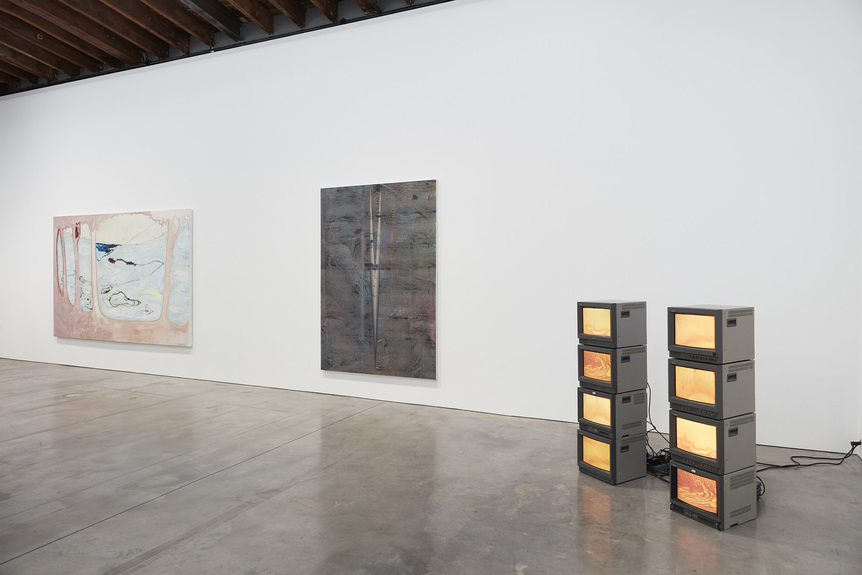-
From Current Issue
-
- Editor’s Letter Fire in the Heart
- Reviews I Gusti Ayu Kadek Murniasih
- Reviews 11th Seoul Mediacity Biennale: “One Escape at a Time”
- Dispatch Networked China
- One on One Monira Al Qadiri on Yukio Mishima
- Essays The rise of independent art spaces in pandemic-era Shanghai
- Features Tuan Andrew Nguyen
- Table of Contents
- Web Exclusives
- Archive
- Subscribe

R
E
V N
E
X
T
Installation view of “A Composite Leviathan: 12 Emerging Artists from China,” 2019, at Luhring Augustine Bushwick. Courtesy Luhring Augustine, New York.
Besides their status as rising Chinese artists, neither immediate themes nor a single medium united those included in “A Composite Leviathan: 12 Emerging Artists from China,” staged at Luhring Augustine’s Bushwick gallery. Befitting its title, the show was characterized by variety, with artworks ranging from figural to abstract, and grappling with both sociopolitical and purely formal concerns.
The show’s namesake, Yang Jian’s A Composite Leviathan (2018), commanded from the center of the first-floor gallery, the massive mutant of rusted rebar and metal towering over nearby works. Plates depicting parts of real and mythical creatures—horns, claws, a human torso—stick to Leviathan’s gnarled wire infrastructure, which is roughly shaped into the head of a dragon. The creature is a sign of power in Chinese mythology, though Yang’s one looks like it has fallen on hard times, and not as mighty as the references conjured by its name: Jewish mythology’s multi-headed sea monster epitomizing God’s power to create, and Thomas Hobbes’ foundational book arguing for absolute rule. By using lead scraps taken from various public parks for the structure’s spotty coating, Yang reinforces the composite aspect of the work. In effect, Leviathan’s shabby appearance reveals the nature of China’s sovereignty; it isn’t monolithic but measured, with the government permitting spaces of limited freedom while extending repression elsewhere.
If Leviathan drew the eyes, Golden River (2017) filled the ears. Wu Di’s installation could be heard throughout the main floor, its steady hum sounding like a plane in flight. Placed in a corner, Golden River consists of two columns of four TVs stacked atop each other. Beaming from the monitors is close-up footage of amber liquid moving at the rate of molasses. The immersive ambient sound hooked the viewer who, staring at a fixed spot on a single screen, could notice time’s plasticity as the scan lines of the tube TV flickered, making the flow onscreen appear even slower. Simple, gaudy, and captivating, Golden River was the highlight of the show. It played upon the senses, inducing an entrancing state, and muting one’s awareness of the surrounding environment.
Installation view of YANG JIAN’s A Composite Leviathan, 2018, lead, rebar, wire, cement, polyurethane foam, 350 × 150 × 150 cm, at “A Composite Leviathan: 12 Emerging Artists from China,” 2019, Luhring Augustine Bushwick. Copyright the artist. Courtesy the artist, White Space Beijing and Luhring Augustine, New York.
“A Composite Leviathan” continued on the second floor, but a casual visitor could easily miss this part due to the lack of signage. The upper level housed comfortably spaced artworks, including Liu Fujie’s abstract sculptures of round wire and flesh-toned cotton on stands, Portrait-ball and Body-ball (both 2017). However, two of Liu’s other pieces, No. 5 / Ball No. 5 and Space-inside (both 2017), composed of plaster and wire molded into surrealistically melting shapes, were nonchalantly placed on top of a chest of drawers. Out of sight and out of mind, the gallery put slightly less care in the presentation of these works.
Found on the ground at the end of the room, the most striking work on the second floor was Nabuqi’s The Doubtful Site (Engulfing and Radiating Shapes) (2018), part of a sculptural series about the architecture of public spaces. Several gray, green, brown, and white pieces of aluminum and resin—recalling 3D chunks from the cartoon Gumby—form the stands of a coliseum. Scaled down to the size of a train set, combined with the muted colors and plastic building-blocks texture, the work has a toy-like quality. Yet, as the sculpture’s name suggests, there is something menacing about this Greco-Roman design, typically used for blood sports and theater. The encircling shape is constrictive, leading the eye towards the blank, void-like center of the ring, which in this case is the cement gallery floor.
Installation view of NABUQI’s The Doubtful Site (Engulfing and Radiating Shapes), 2018, aluminium, resin and sand, 40 × 350 × 350 cm, at “A Composite Leviathan: 12 Emerging Artists from China,” 2019, Luhring Augustine Bushwick. Copyright the artist. Courtesy the artist; CLC Gallery Venture, Beijing; and Luhring Augustine, New York.
“A Composite Leviathan” found room for such disparate artists as Yang, Wu, and Nabuqi, offering a sample platter of art. It wasn’t a cohesive exhibition, and never set out to be in the first place. Instead, the show amplified the veritable diversity among the artists represented, unleashing their unruly, monstrous talent in the United States.
“A Composite Leviathan: 12 Emerging Artists from China” is on view at Luhring Augustine Bushwick, New York, until December 21, 2019.
To read more of ArtAsiaPacific’s articles, visit our Digital Library.


















